|
|
|
 |
 |
 |
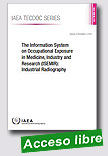 |
The Information System on Occupational Exposure in Medicine, Industry and Research (ISEMIR): Industrial Radiography
IAEA TECDOC, 2014, 275 p.
The International Atomic Energy Agency (IAEA) initiated in early 2009 the Information System on Occupational Exposure in Medicine, Industry and Research, referred to as the ISEMIR project.
The catalyst for the ISEMIR project was the experience of the Information System on Occupational Exposure (ISOE) of .
|
nuclear power plant operators around the world, where having a database that contained detailed information on operational occupational doses across many nuclear power plants enabled the comparison and benchmarking of doses for specific occupations, functions and tasks. This in turn enabled the assessment of the impact of various radiation protection actions. As the ISOE database became populated with data covering many years, dose trends were also able to be analysed. If such an approach was successful for nuclear power plant workers, perhaps a similar approach could be utilized in the non-nuclear domain i.e. medicine, industry and research.
The ISEMIR project was overseen by an Advisory Group, whose first task was to identify a limited number of specific areas of radiation use in medicine, industry and research where non-trivial occupational exposures occur, and which might benefit from such an approach as described above.
The Advisory Group of ISEMIR identified two such areas of radiation use, namely
interventional cardiology (IC) and industrial radiography (IR), and two separate working groups were formed to address these areas. This TECDOC will discuss only IR. A companion TECDOC covers IC.
Extraído de: http://www-pub.iaea.org/MTCD/Publications/PDF/TE-1747_web.pdf
|
 |
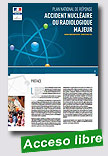 |
National Response Plan - Major Nuclear or Radiological Accidents
Secrétariat Général de la Défense et de la Sécurité Nationale, February 2014, 117 p.
France uses nuclear technologies to produce the electricity needed to power its economy and thus strengthen its energy independence and ensure its defense capabilities. Radioactivity is used in many fields in France, including medicine and research. France s choice of using nuclear power as a source of energy implies an absolute requirement
|
for ensuring the safety of nuclear facilities and nuclear materials during their transport.
Although these new technologies are used to advance and protect society, none are devoid of risks for people and the environment. Therefore, as part of their responsibilities to protect people and the environment, the French public authorities have established a very stringent system for managing and controlling nuclear activities in order to prevent severe accidents. This system is recognized for its effectiveness. However, it is not founded solely on prevention. It includes a local and national emergency-response organization that goes hand in hand with the requirement to provide the public with timely, transparent and clear information in the event of an accident. Despite the progress made, there is always the possibility of an accident, as evidenced by the Fukushima-Daiichi disaster. The disaster,
which has seriously undermined trust in nuclear power, prompted complementary safety assessments of France s nuclear facilities. These assessments took into account beyond-design-basis conditions.
In accordance with the guidelines contained in France´s White Paper on national defense and security, the French government has defined a set of measures and plans to handle various threats or emergencies that occur within or outside France s borders. Within this context of changing strategy and policy, planning actions are carried out both nationally and regionally. There are also specific plans for responding to specific situations. In the event of a nuclear or radiological accident, bringing the affected facility back to a controlled and stable state is not the only necessity. The public authorities and the operator must be able to react to a potential escalation by planning and organizing the best possible means of response that will mitigate the accident s consequences on people and the environment. This is the objective of regional plans already in place.
However, if the national emergency-response organization is to remain efficient, it must be updated regularly. This is the responsibility of the entire French government under the leadership of the French prime minister. It must rely on rance s human strengths from its elected officials and local authorities, healthcare professionals, the economic sector and the scientific community, to its citizens, who play a community role in helping isolated or vulnerable people.
This plan meets this requirement. It sets out how emergency management is organized, the strategy to be implemented and the main measures to be taken by the French government.
Extraído de: http://www.sgdsn.gouv.fr/IMG/pdf/N_Plan.pdf
|
 |
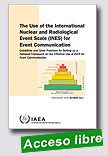 |
The Use of INES for Event Communications: Guidelines and Good Practices for Setting Up a National Framework on the Effective Use of INES for Event Communications
IAEA Non-serial Publications, October 2014, 44 p.
This publication is intended to assist Member States to establish or improve their national framework to effectively use INES as an integral part of their communication strategy. The objective is also to provide examples of existing practices to illustrate the breadth of approaches that can be adopted to meet the fundamental goal of INES, which is to effectively and consistently communicate the safety significance of an event. |
Extraído de: http://www-pub.iaea.org/MTCD/Publications/PDF/INES_web.pdf
|
 |
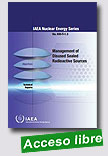 |
This publication summarizes the reviewed information distributed in previous IAEA publications and provides an up to date, overall picture of the management of disused sealed radioactive sources (DSRS) based upon the current status and trends in this field. It incorporates the most recent experience in source management, including newly developed techniques used for DSRS conditioning and storage. Problems encountered and lessons learned are also highlighted in the publication in order to help avoid the mistakes commonly made in the past in managing disused sources.
|
Extraído de:
http://www-pub.iaea.org/books/IAEABooks/10582/Management-
of-Disused-Sealed-Radioactive-Sources |
 |
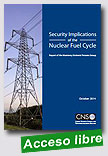 |
Security Implications of the Nuclear Fuel Cycle
James Martin Center for Nonproliferation Studies, October 2014, 8 p.
In 2013-2014, the James Martin Center for Nonproliferation Studies (CNS) at the Monterey Institute of International Studies (MIIS) convened a group of distinguished American and Japanese experts on nonproliferation to examine the security implications of the nuclear fuel cycle.
|
Extraído de:
http://www.nonproliferation.org/wp-
content/uploads/2014/10/141028_nuclear_fuel_
cycle_security_implications_lewis.pdf?utm_
source=NSSPI+News+Digest&utm_campaign=
a47a90759a-RSS_EMAIL_CAMPAIGN&utm_
medium=email&utm_term=0_d96553fdd0-a47a90759a-51249257
|
 |
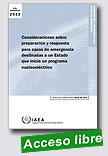
|
Consideraciones sobre preparación y respuesta para casos de emergencia destinadas a un Estado que inicie un programa nucleoeléctrico
IAEA Emergency Preparedness and Response, Julio 2014, 112 p.
Los objetivos de esta publicación son ayudar a los Estados que están considerando iniciar un programa nucleoeléctrico a adquirir un nivel apropiado de preparación y respuesta para casos de emergencia radiológica antes de poner en servicio su primera central nuclear y asegurar el mantenimiento del programa de preparación y respuesta para casos de
|
emergencia durante toda la vida útil de la instalación. Se busca respaldar los principios fundamentales de seguridad y los requisitos internacionales sobre la preparación y respuesta para casos de emergencia formulados en la publicación de la Colección de Normas de Seguridad del OIEAGS-R-2 y las correspondientes directrices de las Guías de Seguridad del OIEA. No GS G-2.1 y No GSG-2. Además, esta publicación concuerda con otraspublicaciones del OIEA elaboradas para dar orientaciones a los Estados que inician un programa nucleoeléctrico, concretamente, la NG-G-3.1, “Milestones in the Development of a National Infrastructure for Nuclear Power”, y SSG-16, “Establishing the Safety Infrastructure for a Nuclear Power Programme”.
Extraído de: http://www-pub.iaea.org/MTCD/Publications/PDF/EPR-Embarking_2012s_web.pdf
|
 |
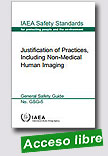 |
Justification of Practices, Including Non-medical Human Imaging
IAEA Safety Standards Series, 2014, 57 p.
This Safety Guide was developed to assist governments and regulatory bodies with the assessment of particularly challenging proposals for the use of radiation; in particular, in human imaging for purposes other than medical diagnosis, medical treatment or biomedical research, such as for security screening at airports. It complements the guidance provided in the IAEA Safety Guide on the Regulatory Control of Radiation |
Sources. It provides guidance to governments and regulatory bodies on the elements that should be considered and the process that should be applied in determining whether the introduction of a particular type of practice is justified. It is intended to assist in the decision making process when confronted with a need or a request to authorize a novel type of practice or a need to review the justification of types of practice that are already established. The publication also provides some guidance to those wishing to demonstrate to the government or regulatory body that a particular type of practice is justified.
Extraído de:
http://www-pub.iaea.org/books/IAEABooks/10670/Justification-of-Practices-Including-Non-medical-Human-Imaging
|
 |
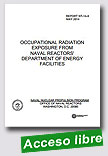 |
Occupational Radiation Exposure from Naval Reactors´ Department of Energy Facilities
Naval Nuclear Propulsion Program, Office of Naval Reactors (USA), May 2014, 66 p.
The Naval Nuclear Propulsion Program is a joint Department of Energy / Department of the Navy Program with central control by a single headquarters organization. Within the Department of Energy, the organization is designated as the Office of Naval Reactors. It operates two Department of Energy laboratories; one Department of Energy site with two operating and one |
inactive prototype naval nuclear propulsion plants; one Department of Energy site that operates the Expended Core Facility (for dispositioning of naval fuel and examination of irradiated test specimens) and has three inactive prototype nuclear propulsion plants; and nuclear component engineering and procurement organizations. Table 1 shows the facilities that have conducted radioactive work associated with the Naval Reactors Program and the date when such work began. Naval Reactors' Department of Energy facilities provide research and development, engineering, training, and supply support for the Navy's 72 nuclearpowered submarines and 10 nuclear-powered aircraft carriers in operation at the end of 2013.
Radiation exposures to personnel monitored for radiation associated with Naval
Reactors' Department of Energy facilities are summarized in this report. Also included in this report is radiation exposure information from the Shippingport Atomic Power Station, near Pittsburgh, Pennsylvania, prior to its dismantlement. Shippingport was developed by the Naval Reactors Program (in conjunction with Duquesne Light Company) as the world's first full-scale nuclear power plant solely for the production of electricity. Shippingport began operation in 1957. Starting in 1974, the light water breeder reactor (LWBR) core was installed at Shippingport. This was the first reactor to prove that fuel breeding was possible in a water-cooled plant. Shippingport was shut down in 1982 and, following defueling, was turned over to another Department of Energy office for dismantlement in 1984. Dismantlement was completed in 1989, which included removing all radioactive components and returning the site to unrestricted use.
Extraído de:
http://nnsa.energy.gov/sites/default/files/nnsa/09-14-inlinefiles/2014-09-10%20NT-14-3.pdf
|
 |
|
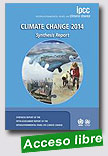
|
Climate 2014: Fifth Assessment Report (AR5) - Synthesis Report
Intergovernmental Panel on Climate Change (IPCC), 1 November 2014, 116 p.
AR5 provides a clear and up to date view of the current state of scientific knowledge relevant to climate change. It consists of three Working Group (WG) reports and a Synthesis Report (SYR). Further information about the outline and content and how the AR5 has been prepared can be found in the AR5 reference document and SYR Scoping document. Information about how the AR5 was prepared can be found here.
|
Summary for Policymakers | Synthesis report
Extraído de: http://www.nrc.gov/reading-rm/doc-collections/news/2014/14-069.pdf
|
 |
| |
|
|
| |
| |
|
|
| |
|
|
|
| |
|
|
|
| |
|
|
|
|
|
